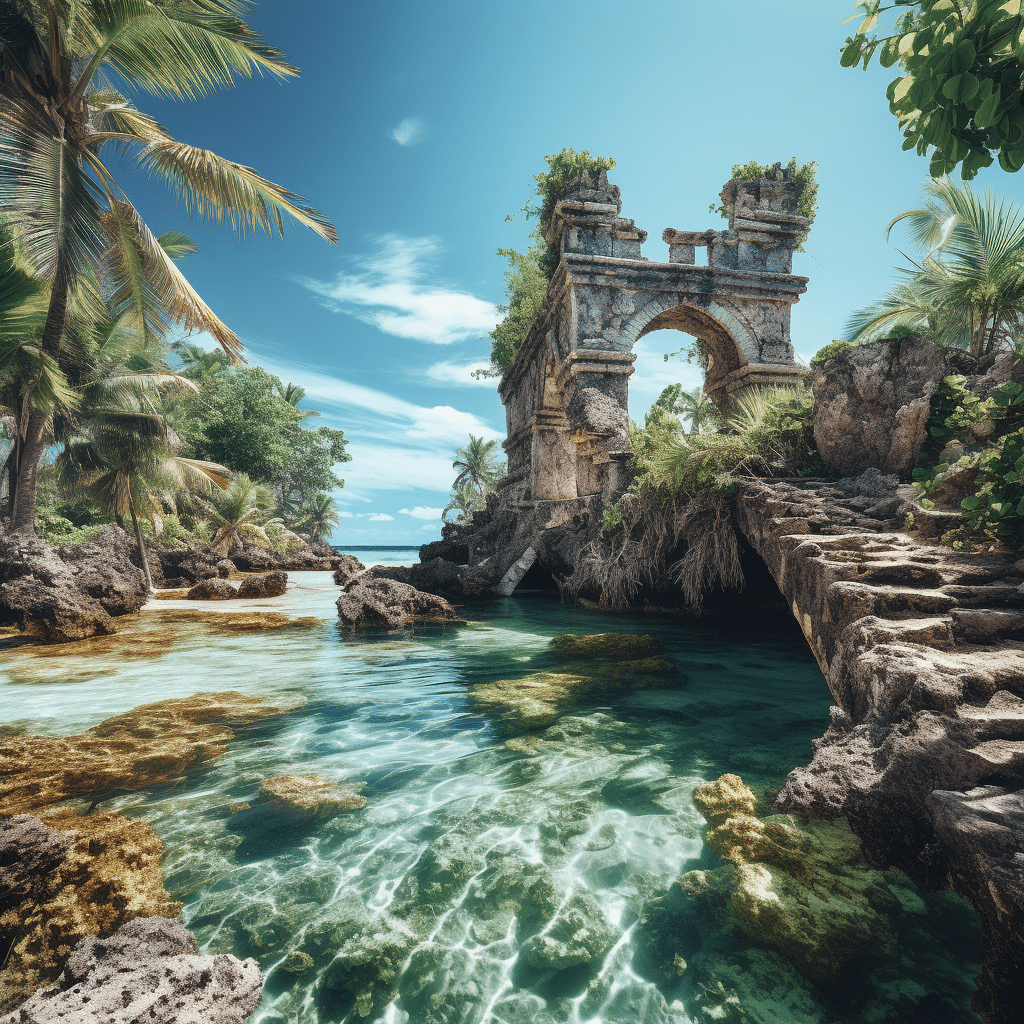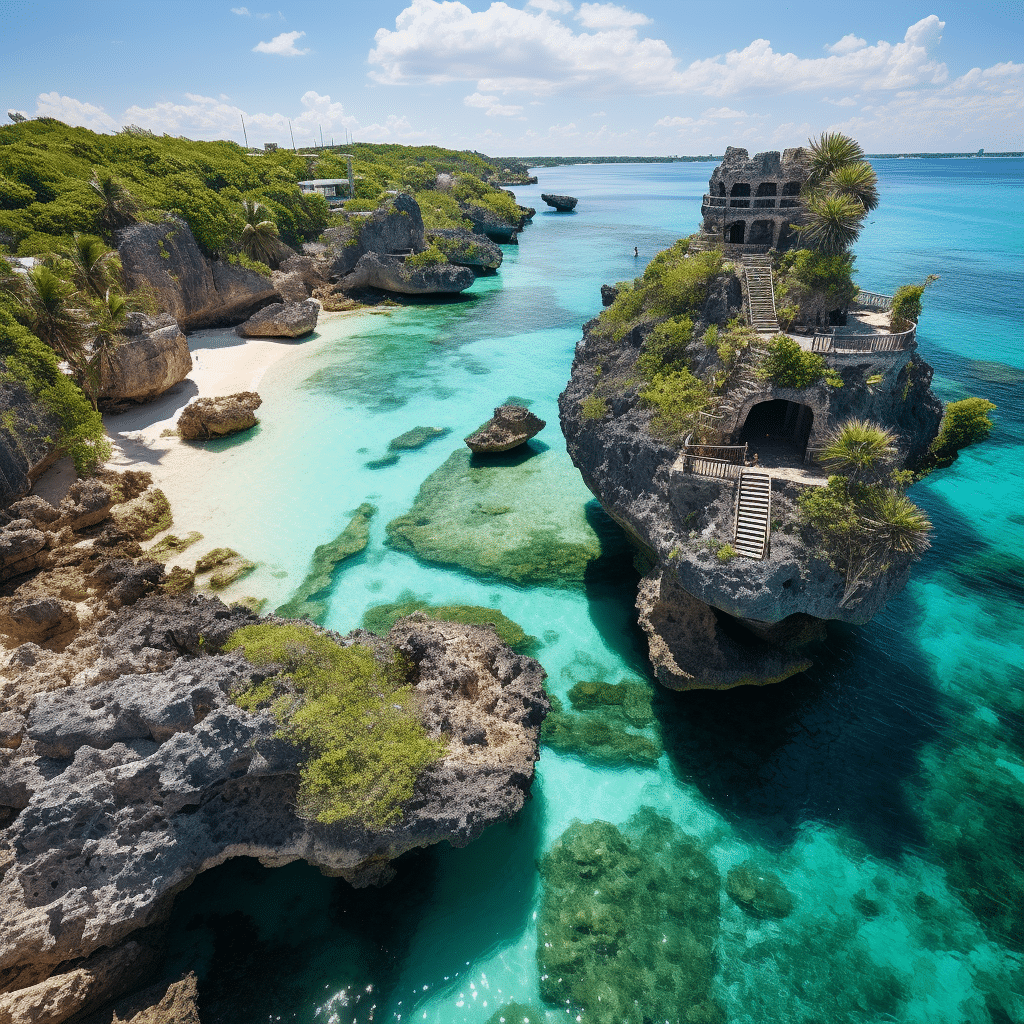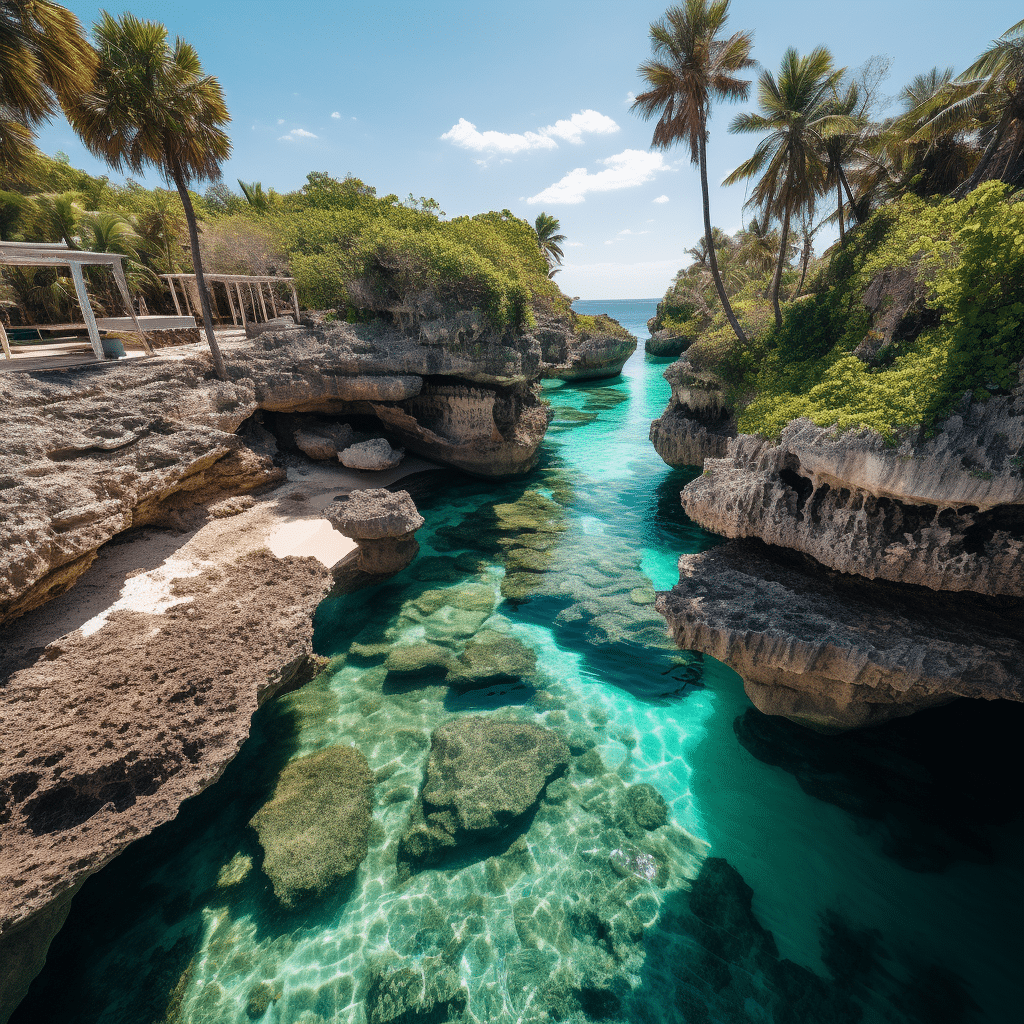Welcome to Quintana Roo, Mexico, a world far beyond the surface-level vacations and beach resorts. Featuring a breathtaking combination of blue sea, shimmering white sand beaches, lush tropical jungles, and intriguing archaeological sites, Quintana Roo, Mexico is a unique gem in the world of tourism. But dig a little deeper, plunge below the surface, and one can discover what lies at the heart of this verdant paradise: the mesmerizing cenotes, which channel a sense of ethereal beauty and whisper tales from a time gone by.
Quintana Roo, Mexico: A Breathtaking Realm Beyond Surface-Level
As the easternmost state of Mexico, Quintana Roo has some of the Caribbean’s most attractive destinations and draws visitors worldwide. Quintana Roo’s status as a tourism hotspot is a recent development, springing up over the past few decades, with tourism primarily fueling Quintana Roo’s fame.
Understanding Quintana Roo Mexico
For starters, Quintana Roo boasts a coastal city named after the famed territory carved from Yucatán and Campeche states in 1902. Quintana Roo was named in honor of Andrés Quintana Roo, a distinguished writer and fervent protagonist in the Mexican wars for independence. The state was officially recognized in 1974.
Decoding the Allure: Why Quintana Roo, Mexico is a Must Visit
Quintana Roo, Mexico, aptly named the “Mexican Caribbean,” consistently wins over tourists with its idyllic coastline. But let me tell you a secret, the region doesn’t solely cater to beach-loving globetrotters. It offers a wealth of history, culture, and adrenaline-pumping adventures to captivate all types of travelers.
The Cenotes of Quintana Roo, Mexico: Unearth Hidden Treasures
We’re stepping off the beaten path now, diving into the dint of Quintana Roo’s fantastical cenotes.

Basic Understanding of Cenotes
Cenotes, naturally occurring sinkholes common in Mexico’s Yucatán Peninsula, are formed by the dissolution of rock that exposes groundwater beneath. Enticingly, these cenotes form a network of underground rivers and caves, providing adventurous souls with unmatched underground exploration opportunities.
Importance and Attraction of Cenotes in Quintana Roo, Mexico
Boasting over 6,000 cenotes, Quintana Roo, Mexico, offers unsurpassed opportunities for divers to swim, snorkel, or dive in limestone caverns while exploring the distinctive flora and fauna. The cenotes’ resultant enchanting mix of sunlight and clear fresh water unveils a visual spectacle, a scene right out of a Disney Das pass story.
An Unseen Phantasm: The Tactical Appeal of Quintana Roo Cenotes
The cenotes of Quintana Roo are ethereal portals into another realm, displaying a mesmerizing blend of water, earth, air, and fire. These intriguing holes are indeed “phantasms,” silent observers of history and carriers of old tales and traditions.
Issues and Challenges in Preservation of Cenotes
Despite their appeal, Quintana Roo’s cenotes face an array of threatening challenges. Pollution, lack of regulation, and overtourism are severe problems. The burgeoning tourism industry, while fantastic for the local economy, unfurls a worrying Tennessee police scandallike narrative, with sustainable practices sometimes tossed overboard.
| **Fact/Feature** | **Description/Detail** |
|---|---|
| :———————————–: | :———————————————————————-: |
| Location/Region | Mexican Caribbean, part of the Yucatán Peninsula |
| Inception/Formation Date | Carved from parts of Yucatán and Campeche states in 1902, made a state in 1974 |
| Named After | Andrés Quintana Roo, a writer & leader in the Mexican wars for independence |
| Main Attractions | Blue sea, white sand beaches, tropical jungle, archaeological sites, cenotes and underground rivers |
| Cultural Significance | Alive Mayan culture and history |
| Distance to Major City (Cancun) | 11 miles (17 km) |
| Known For | Major tourism destination, particularly its beaches, coastline, and cenote sinkholes |
| Current Issues | Violence due to the rise of the Jalisco New Generation Cartel (CJNG) |
| Historical Importance | Key to shaping Mexico’s formal declaration of independence |
Plunge into the Crystal Depths: An Exploration of Quintana Roo, Mexico’s Cenotes
As we plunge deeper into Quintana Roo, Mexico’s cenotes, let’s explore a few dive sites that will leave you in awe.
Quintana Roo’s Cenote Dive Sites: Unveiling the Dazzling Underwater Scenery
From the Dos Ojos (“Two Eyes”) circled by crystal water to the hidden underworld of Angelita (“Little Angel”), Quintana Roo, Mexico’s cenotes, offers a plethora of sights for both seasoned and novice divers alike.
Be Enthralled with the Ethereal Beauty: Cenote Dos Ojos
Staring into Dos Ojos is akin to staring into the eyes of Mother Nature herself. With visibility at a stunning hundred feet, divers can easily lose themselves in the submerged labyrinth of passageways and caves.
The Underwater Cave System: Cenote Sac Actun
Sac Actun, or “White Cave,” is an intricate network of underwater tunnels and the longest inundated cave system globally. Here, you can dive into the serene depths, adventuring through impressive stalactite formations.
The Hidden Underworld: Diving in Cenote Angelita
Now, if you’re into eerie underwater experiences, don’t skip Cenote Angelita. A thick, murky cloud of hydrogen sulfide separates fresh water from the saltwater below, creating the illusion of a breathtaking underwater river.

The Significance of Cenotes in Quintana Roo, Mexico: Going Deeper than Surface-Level
As dazzling as the visual spectacle may be, Quintana Roo, Mexico’s cenotes offer much more than awe-inspiring sceneries. They serve as navigational aids, ceremonial sites, and archaeological treasure troves, providing a precious link to the past.
A Step Back in Time: The Archaeological Value of Cenote Samula
Cenote Samula homes spectacular rock formations, but it also hosts remnants of the Mayan era, fossils, and even human bones. The cenote allows us to step back into an archaeological haven, offering valuable insight into the Mayan civilization.
Spiritual Significance: Mayan Rituals and Cenote Zapote
Historically, cenotes represented gates to the underworld for the Mayans. Cenote Zapote, known locally as “The Hell’s Bells,” hosts a ceremonial site probably used for rituals and sacrifices.
Safeguarding the Sunkissed Aquamarine: Action toward Conservation in Quintana Roo, Mexico
It’s crucial to sustain the efforts made towards preserving the cenotes of Quintana Roo, Mexico. Take a dip in the conservation efforts initiated by the local government and communities, lulled by the rhythmic lullaby of the sea.
Addressing the Challenges: Conserving Quintana Roo Cenotes
Like a Nutramigen formula providing sustenance for babies, Quintana Roo’s cenotes provide life to the local ecosystem. However, they face threats from pollution, unregulated tourism, and land development. It’s a call to action for all involved parties to implement effective regulation and conservation strategies.
Local Initiatives and Actions
Locally, there’s a gradual shift in cognizance, with multiple initiatives geared towards maintaining the cenotes’ health. From community efforts to clean lakes to private entities working on sustainable tourism models, progress is ongoing.
Steps You Can Take to Help
As a visitor, you can play your part. Start by choosing responsible tour operators who adopt sustainable practices, improve local livelihoods, and foster conservation awareness. Your actions can make a difference, as even the smallest pebble can cause ripples in the water.

Quintana Roo, Mexico: Waters Less Traveled
Quintana Roo, Mexico beckons the travelers to explore not just its surface but even the depths beneath. The story of its cenotes is well worth the dive.
Retracing the Journey: Beyond the Pristine Cenotes of Quintana Roo, Mexico
The journey through Quintana Roo’s cenotes is an evocative one, often leaving treaders with an experience more profound than expected. It’s a travel tale bookended by the azure embrace of the sea and the hushed whispers of the cenotes.
As Quintana Roo, Mexico’s tourism industry thrives, the government and various organizations are taking up the mantle of ensuring that this growth doesn’t compromise the cenotes’ inherent beauty and ecological balance.
Lessons from the Depths: The Enduring Charm of Quintana Roo, Mexico
In essence, the cenotes of Quintana Roo, Mexico teach us about respect for nature, unveiling the delicate balance that exists between man and his environment. A dive into its cenotes is not just a sporty adventure but also a humbling reminder of our place in the larger schema of things.
Final Diver’s Note: The Cenotes of Quintana Roo, Mexico
Leave your footprints on the pristine beaches, let the sea whispers guide your wanderings, and plunge into the aquamarine depths of Quintana Roo, Mexico’s cenotes. Discover an uncharted territory lurking beneath the surface, drowning in secrets, shimmering in unexplored beauty. Don’t just scratch the surface, dive into the depths, and let the Quintana Roo cenotes echo their tales in your memories.
What is special about Quintana Roo?
Boy oh boy, Quintana Roo is a real gem! This beautiful Mexican state is unique for its surreal natural beauty that includes mind-blowing Caribbean beaches, breathtaking archaeological sites, mesmerizing underwater caves, and astonishing Mayan cultural immersions.
Why is Cancun called Quintana Roo?
Contrary to popular belief, Cancun isn’t called Quintana Roo. You might be scratching your head, but here’s the tea: Cancun is a city located in the Mexican State of Quintana Roo. In other words, Cancun dances to Quintana Roo’s beat.
What is the Quintana Roo area in Mexico?
When we speak about the Quintana Roo area in Mexico, we’re referring to a dazzling region with a smorgasbord of tourist destinations such as Cancun, Cozumel, Tulum, and the Riviera Maya. Its allure lies in its untamed tropical charm, vibrant underwater life, historical treasures, and balmy Caribbean weather.
What is the safest area in Quintana Roo?
Looking for the safest area in Quintana Roo? Look no further! Cozumel tops the bill with its lower crime rate, tight-knit community, and well-regulated safety measures. This island is a slice of peaceful paradise in Quintana Roo.
Is Quintana Roo safe for Americans?
Is Quintana Roo safe for Americans? Absolutely! Thousands of American tourists and expats enjoy Quintana Roo sans any major issues every year. Just be street smart and you’re good to go!
What’s the difference between Cancun and Quintana Roo?
Cancun and Quintana Roo are often swapped but here’s the deal: Cancun is a city while Quintana Roo is a state which Cancun is part of. Imagine someone mistaking New York City for New York state – it’s kinda like that!
What language is spoken in Quintana Roo?
Quintana Roo, just like the rest of Mexico, primarily speaks Spanish. So, dust off your Spanish lexicons when you head this way! But don’t get your knickers in a twist if you don’t, as English is widely understood owing to the region’s tourism.
What food is Quintana Roo known for?
Quintana Roo will delight your taste buds! Its gastronomy boasts fresh seafood, traditional Mexican cuisine and original Mayan dishes. Sink your teeth into a delicious Pibil Chicken or savor a divine Tikin-Xic fish – you’ll feel like you’ve died and gone to food heaven.
Is Quintana Roo and Riviera Maya the same?
Nope, Quintana Roo and Riviera Maya aren’t the same! Riviera Maya is one of the many vibrant, sun-smooched jewels in Quintana Roo’s regal crown.
Is it expensive to live in Quintana Roo Mexico?
Living in Quintana Roo can lean towards the pricier side, especially in tourist hotspots like Cancun and Tulum. Though, it’s cheaper than major US cities. Depends on what you’ve got in your piggy bank, really!
Where are the no go zones in Mexico?
As for no-go zones in Mexico, the U.S. Department of State advises exercising caution or altogether avoiding states like Tamaulipas, Michoacán, and Chihuahua due to safety concerns. Don’t get cold feet though, plenty of other places are welcoming.
What does Quintana Roo mean in English?
Quintana Roo in English? It’s simple – the name doesn’t have a translation. It’s the namesake of Andrés Quintana Roo, a Mexican federalist and freedom fighter. No secret code, just a cool name!
Is Cancun safe from cartels?
As for Cancun, it’s generally safe from cartels. Aye, there were isolated incidents but the tourist-centric areas mostly remain peaceful. Just exercise normal precautions and stick to areas that aren’t off the beaten path.
What cartel runs Playa del Carmen?
Playa Del Carmen, as part of Quintana Roo, generally sees the influence of multiple cartels but currently, it’s believed the Jalisco New Generation Cartel holds considerable sway. However, they mostly operate behind the scenes and typically do not affect vacationing tourists.
What is the homicide rate in Quintana Roo?
The homicide rate in Quintana Roo can be a bit shaky with fluctuations from year to year, but generally, tourists aren’t the targets. Safety measures and precautions are underway to make your visit as safe as possible. Always remember, awareness is key to staying out of harm’s way.



























